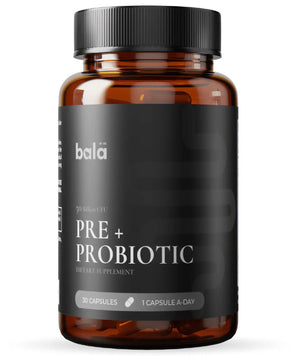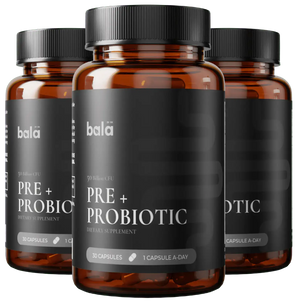Table of Contents
Introduction
Did you know that nearly 70% of our immune system is housed in the gut? This staggering statistic highlights the profound impact our digestive health has on our overall well-being. As we dive deeper into the wellness conversation, we often encounter terms like "prebiotics" and "probiotics"—buzzwords that promise to enhance our digestive health, boost immunity, and even uplift our mood. But with so much information out there, we may wonder: when do we take prebiotics and probiotics to maximize their benefits?
At Bala Health, we understand that navigating the world of gut health can be overwhelming. Many of us face challenges like bloating, irregular digestion, and fluctuating energy levels. The good news is that incorporating prebiotics and probiotics into our daily routines can be part of the solution. In this blog post, we’ll explore what prebiotics and probiotics are, their synergistic effects, and the best practices for incorporating them into our wellness regimen.
By the end of this article, you’ll have a clearer understanding of when and how to take prebiotics and probiotics, along with insights into our clean, science-backed probiotic formula designed to support your gut health journey.
Understanding Prebiotics and Probiotics
What Are Prebiotics?
Prebiotics are non-digestible fibers found in various foods that serve as food for the beneficial bacteria residing in our intestines. Think of them as the fertilizer that nourishes the garden of our gut microbiome. Common sources of prebiotics include:
- Garlic
- Onions
- Bananas
- Asparagus
- Chicory root
Taking these fiber-rich foods promotes the growth of beneficial bacteria, enhancing our microbiome's diversity and functionality.
What Are Probiotics?
Probiotics, on the other hand, are live microorganisms—mainly bacteria and yeasts—that can provide health benefits when consumed in adequate amounts. Probiotics are often referred to as "good" or "friendly" bacteria. They can be found in:
- Yogurt
- Sauerkraut
- Kefir
- Kimchi
In supplement form, probiotics come in various strains, with Lactobacillus and Bifidobacterium being the most common. These strains help maintain a healthy balance of gut flora, aiding digestion and supporting our immune system.
The Synergy Between Prebiotics and Probiotics
When taken together, prebiotics and probiotics create a synergistic effect known as "synbiotics." This combination enhances gut health more effectively than either would alone. Prebiotics feed the probiotics, helping them thrive and multiply, which can lead to improved gut health outcomes.
When to Take Prebiotics and Probiotics
Timing Matters
The timing for taking prebiotics and probiotics can influence their effectiveness. Here’s a breakdown of when to take each:
Prebiotics
- Anytime with Meals: Prebiotics can generally be taken at any time, preferably with meals. Including them in your diet regularly ensures that beneficial bacteria have a consistent food source to thrive on.
- Morning or Night: Some people may choose to take prebiotics in the morning to kickstart digestion after an overnight fast, while others may prefer taking them in the evening to promote gut health overnight.
Probiotics
- On an Empty Stomach: For maximum effectiveness, probiotics are best taken on an empty stomach or between meals. The lower acidity in the stomach at these times allows more probiotic bacteria to survive the digestive process and reach the intestines.
- Consistency is Key: Just like any supplement, consistency is crucial. Taking probiotics at the same time daily can help establish a routine and improve gut health benefits.
Combining Prebiotics and Probiotics
For those seeking to optimize gut health, taking prebiotics and probiotics together may yield the best results. This approach not only supports the growth of beneficial bacteria but also enhances the overall health of the gut microbiome.
- Synbiotic Formulations: Products that combine prebiotics and probiotics leverage their synergistic effects. At Bala Health, our flagship probiotic is formulated to include clinically validated strains that work in harmony with prebiotics, ensuring a comprehensive approach to gut health.
Benefits of Prebiotics and Probiotics
Integrating prebiotics and probiotics into our diets can lead to numerous health benefits, including:
- Improved Digestion: Both prebiotics and probiotics can help ease occasional bloating and support regular bowel movements.
- Enhanced Immune Function: A healthy gut microbiome plays a critical role in maintaining immune health. By fostering a balance of gut bacteria, we can support our body's natural defenses.
- Better Nutrient Absorption: Probiotics can enhance the absorption of essential nutrients, including vitamins and minerals, from the food we eat.
- Mood Regulation: Emerging research suggests a connection between gut health and mental well-being, often referred to as the gut-brain axis. A balanced gut microbiome may contribute to improved mood and cognitive function.
How to Incorporate Prebiotics and Probiotics into Your Life
Dietary Sources
- Incorporate Fiber-Rich Foods: Include plenty of fruits, vegetables, whole grains, and legumes in your diet. Foods such as bananas, onions, garlic, and asparagus are excellent sources of prebiotics.
- Enjoy Fermented Foods: Add fermented foods like yogurt, kefir, kimchi, and sauerkraut to your meals. These foods are rich in probiotics and can be delicious additions to many dishes.
Supplementation
If it’s challenging to consume enough prebiotics and probiotics through food alone, supplementation can be a valuable option.
- Choose Quality Supplements: Look for probiotics that contain clinically validated strains and doses, like those offered by Bala Health. Our Bala Health Probiotic is designed to support your gut health with clean, effective ingredients.
- Consider Synbiotics: Products that combine both prebiotics and probiotics can optimize your gut health and are worth considering for those looking for a comprehensive solution.
Monitor Your Gut Health
Pay attention to how your body responds to the inclusion of prebiotics and probiotics. Some people may experience mild side effects, such as gas or bloating, when starting out. This is typically temporary as your gut adjusts.
- Adjust as Needed: If you notice discomfort, consider adjusting the timing or amount you’re taking. It’s always a good idea to consult with a healthcare professional if you have specific concerns about gut health.
Conclusion
Understanding when and how to take prebiotics and probiotics can empower us to make informed decisions about our gut health. By incorporating these beneficial fibers and microorganisms into our routines, we can support our digestion, immunity, and overall well-being.
At Bala Health, we believe in the power of clean, science-backed probiotics. Whether you choose to enhance your diet with fiber-rich foods or explore our Bala Health Probiotic, we’re here to support your journey to better gut health.
Ready to kick-start your transformation? Take our 3-minute Weight-Loss Quiz to discover your personalized gut-health roadmap today!
FAQ
What are the main differences between prebiotics and probiotics?
Prebiotics are non-digestible fibers that feed beneficial gut bacteria, while probiotics are live microorganisms that confer health benefits to the host.
Can I take prebiotics and probiotics at the same time?
Yes! Taking them together can enhance their effectiveness, as prebiotics provide food for probiotics, allowing them to thrive.
Are there any side effects of taking prebiotics or probiotics?
Some people may experience mild digestive discomfort, such as gas or bloating, especially when starting a new regimen. These effects are usually temporary.
How long does it take to see the benefits of prebiotics and probiotics?
The timeline varies for each individual. Many people may begin to notice improvements within a few weeks, but it can take longer for some.
What should I look for in a probiotic supplement?
Choose probiotics with clinically validated strains and doses, like those offered by Bala Health, to ensure you are getting effective support for your gut health.
By focusing on our gut health through the strategic use of prebiotics and probiotics, we can cultivate a thriving microbiome that supports our overall wellness. Let’s embark on this journey together, and remember—feeling better starts from the inside out!







